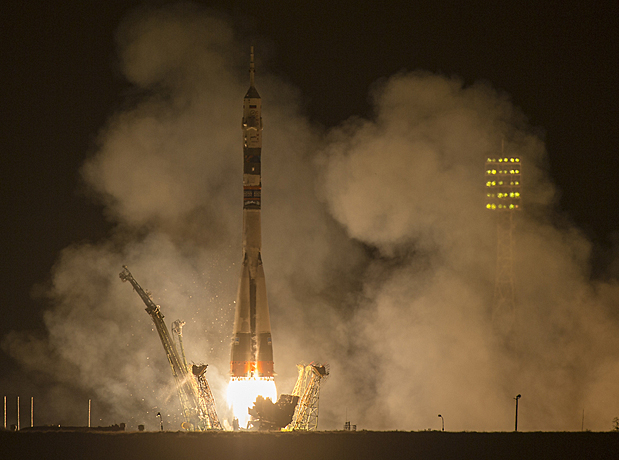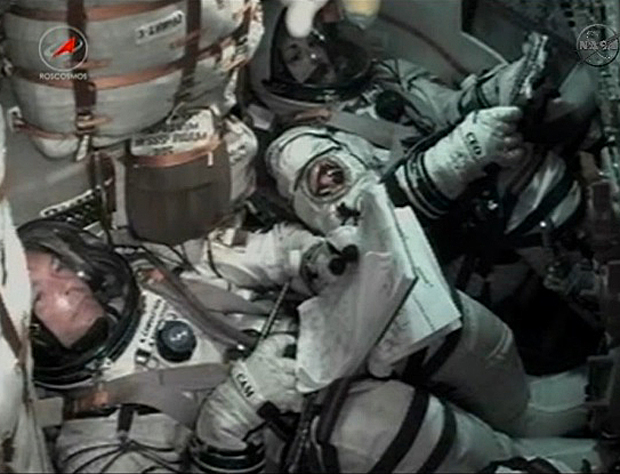Soyuz delivers team of 3 to space station
Looking like a wounded bird with only one of its two solar wings deployed, a Russian Soyuz spacecraft glided to an otherwise picture-perfect docking with the International Space Station late Thursday, boosting the lab's crew back to six with the addition of a veteran cosmonaut, a NASA shuttle flier and the first female cosmonaut to win a station berth.
With commander Alexander Samokutyaev at the controls, flanked on the left by board engineer Elena Serova and on the right by Barry "Butch" Wilmore, the Soyuz TMA-14M spacecraft engaged the docking mechanism on the station's upper Poisk module at 10:11 p.m. EDT (GMT-4) as the two spacecraft sailed 260 miles above the Pacific Ocean approaching the coast of Ecuador.
"Contact and capture confirmed," someone said over a translated Russian audio loop. "Congratulations."
The linkup came six hours -- four orbits -- after a sky-lighting launch from the Baikonur Cosmodrome in Kazakhstan. The eight-minute 45-second climb to space went smoothly, but only one of the Soyuz's two solar panels unfolded after the ship reached orbit.
A little more than a half hour after docking, perhaps helped along by the slight jarring of impact or the extreme temperature swings spacecraft experience in orbit -- or both -- the stuck left-side solar array suddenly popped free, easing any concerns about the ship's return to Earth next March.
"It's fully deployed, and it's as beautiful as they come," Samokutyaev reported in a translated call to Russian flight controllers.
"Now your vehicle is fully awake, finally," a Russian flight controller replied.
"Yeah, I guess, finally."
After extensive leak checks to verify a tight seal, hatches were opened and Expedition 41 commander Maxim Suraev, European Space Agency astronaut Alexander Gerst and NASA flight engineer Reid Wiseman welcomed their new crewmates aboard.
"Elena, hi, this is Mark," Serova's husband radioed during a video conference with friends and family at Baikonur. "You're always looking awesome. I love you. Sasha (Samokutayaev), as always, good job, great job, even with one wing. Hugs and kisses."
Serova's 11-year-old daughter then chimed in, saying "I'm glad everything went nominal. We love you very much. Hugs and kisses!"
"I love you very, very much," Serova replied.
Wilmore's wife said the launch was "totally awesome!" and Wilmore replied "it was pretty good from our end, too."
"Everything went like clockwork," he said a few moments later. "Sasha and Elena, they were doing their part getting us here and the ground teams were great, so it was like click, click, click and here we were before we knew it. We can't wait to see the replay."
Samokutyaev is a veteran of a previous station flight, logging 164 days in space in 2011. Wilmore has a shuttle flight to his credit, serving as pilot of the Atlantis for an 11-day station visit in 2009. Serova, the fourth female cosmonaut and the first to visit the space station, is making her first flight.
"There were a number of women on the ISS before me, but I will be the first Russian woman cosmonaut," she said in a NASA interview. "I never thought about it too much because space is what I do for work, and that's what I think about it: it's my work. But obviously for Russian women it might be a breakthrough in this area."
Cosmonaut Valentina Tereshkova was the first Russian woman in space, launched in June 1963. Svetlana Savitskaya was the second, flying in 1982 and again in 1984. Elena Kondakova was the most recent, flying in 1994 on a Soyuz spacecraft and again in 1997 aboard the space shuttle. Forty-five U.S. women have flown in space, along with nine from other nations.
Married to an aerospace engineer and the mother of an 11-year-old child, Serova is firmly focused on the job at hand, dismissing questions about the greater significance of her mission.
"There have been quite a few female astronauts before me and I don't see my flying as such an outstanding event," said said in a later interview. "Each of us is first and foremost governed by his or her primary tasks aboard the station. So, I would say this is a regular and nominal occurrence. Nothing special."
But like anyone preparing for a space flight, she later admitted "I'm excited and I'm anxious."
"We've been studying for a long time, studying the vehicle, reading the manuals, and now we'll be on our own," she said through a translator. "I think our crew is ready."
Samokutyaev, married and a father of one, said he was pleased with Serova's progress, calling her "my pupil" and adding that "she achieved more than I could hope for."
In an interview with CBS News, he said he welcomed the presence of women in orbit, adding a somewhat less-than-liberated take on roles and responsibilities.
"When I entered (the space) station for the first time I was met by a woman, (NASA astronaut) Catherine Coleman, and for all of us who were new to spaceflight, she was like a mother to us," he said. "We are happy that a Russian woman is going to be flying on ISS, only the fourth woman cosmonaut and the first Russian woman on ISS.
"Of course, we are trying to distribute our duties on board and Elena promised that the cuisine will be delicious! Also, she promised the Russian segment would be very comfortable and cozy, like home."
But Serova is nothing but serious about her role. At a pre-flight news conference, a reporter asked her to talk "more about your, maybe, everyday life on the station, how you see it? For example, your hair, how are you planning to do your hair?"
"I have a question for you," Serova replied. "Why don't you ask the question about Alexander's hair? I'm sorry, this is my answer."
The Soyuz TMA-14M flight comes during a time of increased tension between Russia and the United States in the wake of Russia's annexation of Crimea and the ongoing crisis in Ukraine. Despite U.S. sanctions and an escalating war of words at the diplomatic level, Wilmore said there was no stress among space workers.
He praised his Russian trainers and said everyone had gone out of their way to make him feel welcome.
"From day one, if I didn't watch the news or listen to the news, I would have no idea that there were any political tensions at all with respect to what I've done here," he said in an interview from Moscow. "It's been no different at all. Our instructors here in Russia are very passionate about what they do and ensuring that we are well trained and prepared for our mission, and there's been no change in any of that. They have been wonderful.
"My crewmates, it has not been an issue," he said. "As far as the hierarchy at NASA, Roscosmos and Energia, there's been nothing that I'm aware of that trickled down to my level at all. Like I said, if I didn't know there were some political tensions I would have no idea. It's been wonderful, it's been great."
It's also been a challenge. A veteran Navy fighter pilot with more than 6,800 hours flying time, 663 carrier landings and a shuttle mission to his credit, Wilmore said learning Russian was the most difficult aspect of flying on a Soyuz.
"When I was in high school and college, I never had to learn a foreign language," he said. "But when I got assigned to this mission, understanding at least some portion of Russian was a requirement. So the hardest thing that I've done is learning Russian, by far. There are certain challenges involved with learning a new vehicle, but learning the language is difficult, and it's tough. I'm still learning."
The Expedition 41 crew faces a particularly busy few weeks in orbit, staging three spacewalks in October, unloading and repacking a SpaceX Dragon cargo ship and taking delivery of an Orbital Sciences cargo craft and a Russian Progress supply ship.
Two NASA spacewalks are planned to move a failed ammonia pump module to a long-term storage location on the station's solar power truss and to replace a device called a sequential shunt unit that will restore one of the station's eight power channels to normal operation.  The pump storage spacewalk, by Wiseman and Gerst, is planned for Oct. 7 while the SSU swap out, by Wiseman and Wilmore, is targeted for Oct. 15. Suraev and Samokutyaev plan to venture outside on Oct. 22 to replace materials science experiments and to carry out routine maintenance.
The SpaceX Dragon cargo ship, launched early Sunday morning, is the fourth operational flight under a $1.6 billion contract with NASA that calls for 12 missions to deliver some 44,000 pounds of cargo. The latest Dragon reached the space station Tuesday, approaching from directly below and then holding position while Gerst, operating the station's robot arm, locked onto a grapple fixture so the capsule could be pulled in for berthing at the Earth-facing port of the forward Harmony module.
The spacecraft was loaded with some 2.5 tons of equipment and supplies, including an experimental 3D printer, 20 research mice, an instrument o measure ocean wind speeds and a wide variety of other items, including a month's supply of food, fresh clothing and spare parts.
After unloading the supply ship, the station crew will repack it with some 3,400 pounds of cargo, experiment samples and other components for return to Earth. Unberthing and splashdown in the Pacific Ocean is planned for Oct. 18. Two days later, the Orbital Sciences Cygnus cargo ship, the company's third mission under a $1.9 billion resupply contract, is scheduled for launch from Wallops Island, Va., carrying another load of supplies and equipment.
The Progress M-25M supply ship -- the 57th launched to the station -- is scheduled for takeoff from Baikonur Oct. 29. After that, the combined crew will enjoy several weeks of uninterrupted scientific research and maintenance before Suraev, Gerst and Wiseman depart aboard the Soyuz TMA-13M spacecraft onNov. 10, closing out a 165-day mission.
Their replacements -- Soyuz TMA-15M commander Alexander Shkaplerov, NASA astronaut Terry Virts and ESA flier Samantha Cristoforetti -- are scheduled for launch Nov. 23. Wilmore, Samokutyaev and Serova are expected to spend 167 days in orbit, returning to Earth March 12 next year.
Asked how his family would cope with the long absence, Wilmore said his wife, Deanna, and his two daughters, 7 and 10, were well prepared. NASA has even loaned an iPad to the family for weekly video conferences from orbit.
"My wife, Deanna, is a wonderful mother, a wonderful wife and she teaches our daughters, we home school our daughters and she spends a great deal of time with them and she's helped me prepare them for this entire two-and-a-half year training flow," he said. "It hasn't been that painful. There's a lot of people around our nation, around the globe, that the father's job takes them away from their families. And this one's no different.
"The opportunity to do these things, to have the opportunity to work on the International Space Station is something that's very intriguing for me and I'm trying to give the girls a little bit of that as well, to help them understand the importance of it all. And I think they do."


